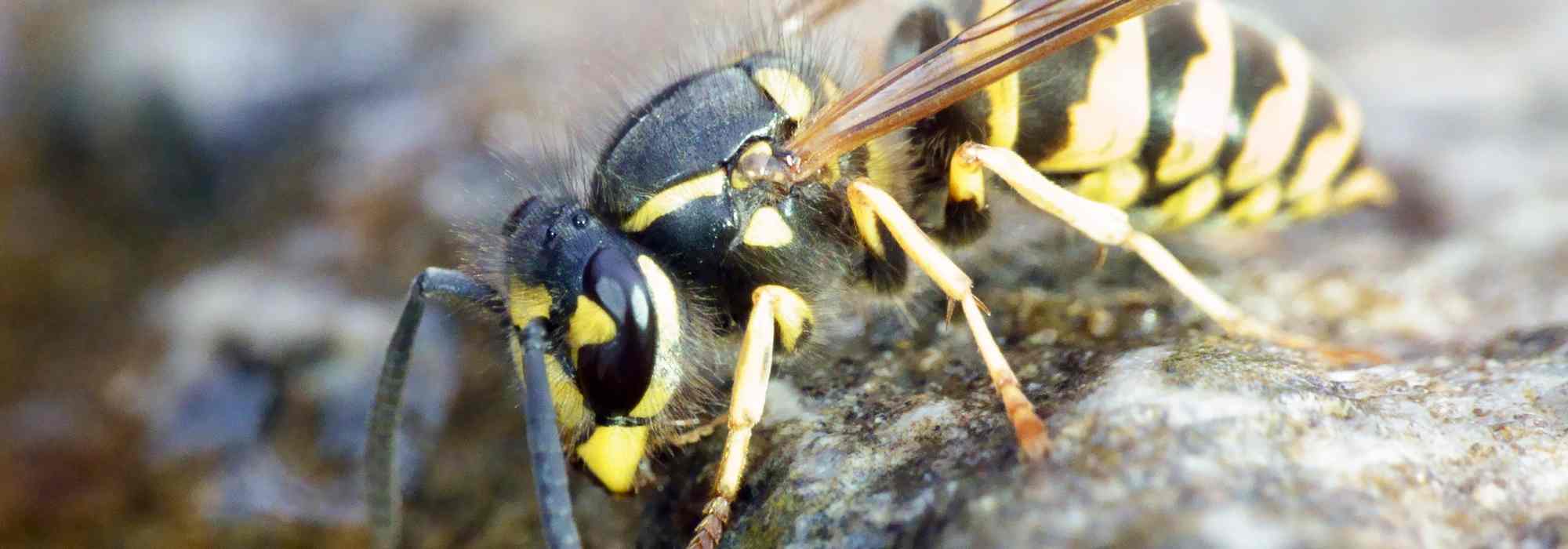
How to limit wasps in the garden without harming biodiversity?
Maintaining garden balance against unwanted insects
Contents
As soon as the fine weather arrives, any meal on the terrace or beneath the foliage of garden trees attracts a few buzzing wasps, somewhat persistent in their approach. Reactions to this intrusion vary: some remain stoic, aware that these wasps are beneficial to the garden, while others make frantic (and ill-advised) movements to shoo them away… at the risk of getting stung. What can be done to dine peacefully while preserving biodiversity? Right away, let’s dismiss lethal solutions ending in -ide or traps to maintain a certain balance in the garden.
Let’s explore together natural solutions and gestures, respectful of your garden’s equilibrium and living creatures, to deter wasps without exterminating them.
Recognising Wasps to Better Accept Them
Before trying to limit their presence, it might be useful to learn how to identify the different wasps you may encounter in the garden. Behind the general term “wasp” actually lie different species, classified into two groups: social wasps (which live in colonies of several hundred to thousands of individuals, organised around a queen in papier-mâché nests) and solitary wasps, which are much more discreet and pose no threat to humans. Admittedly, you might say it’s hard to tell the difference when these wasps are buzzing around you with what you perceive as aggressive behaviour!
Social wasps that live in colonies
These are the ones most commonly seen in the garden, around our plates or sweet drinks:
- Vespula vulgaris or common wasp. This is the most frequent species in Europe. It has a bright yellow body striped with black, a slender waist, and builds spherical papier-mâché nests, often hidden in attics, hedges…
- Vespula germanica or German wasp. Very similar to the common wasp, it can be distinguished by three black dots on its forehead. It nests in underground cavities, hollow walls or under roofs.
- Polistes dominula or European paper wasp. More slender, it is recognisable by its long, pendulous legs in flight. Its nest, small (and thus less visible) and made of open alveolate cells, is often attached under eaves, railings or garden shelters. If the nest is approached, they can become aggressive and sting.
- Dolichovespula media or median wasp. Larger than other common species, it is active from spring and builds its nest in trees or dense hedges, rarely near homes.
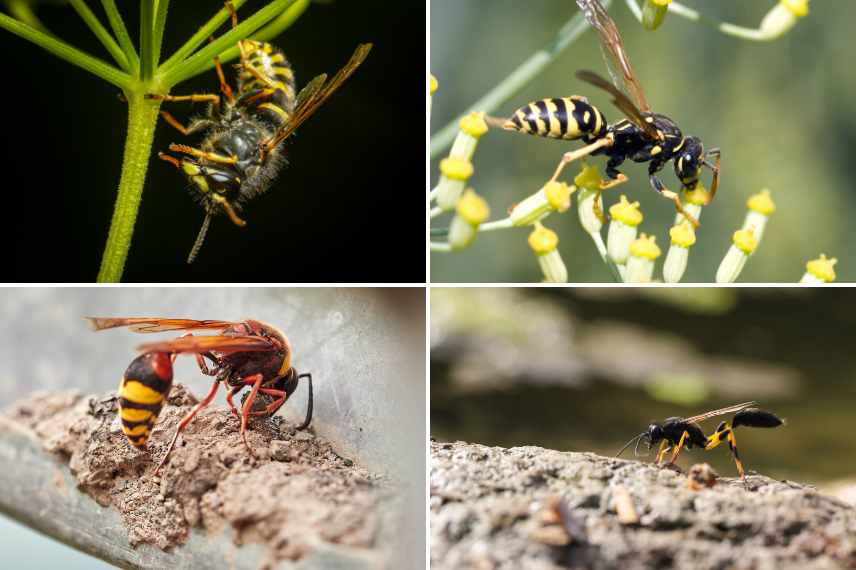
Social wasps at the top (Vespula vulgaris and Vespula germanica) and solitary wasps at the bottom
Solitary wasps, which live alone
Far less noticeable, solitary wasps have no nest to defend, so they are more peaceful:
- Eumenes spp. or potter wasps. They build small urn-shaped nests made of clay or mud, often attached to walls, branches or hollow stems. They are very useful in the garden for regulating insect larvae.
- Sceliphron curvatum or mud dauber wasp. Black with yellow markings, it can be recognised by its very slender waist. It constructs series of mud nests fixed to sheltered surfaces. It hunts spiders to feed its larvae.
- Ammophila spp. or digger wasp. Slender and black with metallic reflections, it digs tunnels in the soil to lay its eggs and deposit paralysed caterpillars. Very discreet, it is only active in full sunlight.
- Sphex spp. or sphex wasp. This solitary terricolous wasp digs tunnels to stockpile prey, usually orthopterans, which it captures to feed its larvae. It is entirely black or bluish-black, with a very peaceful behaviour.
It’s important to note that contrary to their reputation, social wasps are not naturally aggressive. They may become so and sting only if their nest is attacked or simply threatened by human presence. When they hover around the table, it’s only the food that interests them. And logically, they ignore you unless you behave aggressively towards them.
Why Do Wasps Invade Our Gardens? And How to Avoid Attracting Them
What are wasps looking for in your garden? That’s surely the question on your mind. Understanding their motivation will likely help you reduce their presence. As much as possible…
Wasps are hymenopterans that love sugar, which they naturally find in flower nectar or the honeydew secreted by aphids. But they also need proteins, a need that drives them to capture other insects, particularly larvae, spiders, caterpillars… Incidentally, if your garden table is laden with all sorts of sweets, ripe fruits, or meat and charcuterie, they’ll go for the easiest option. To limit their presence, sometimes simply covering food and avoiding leaving leftovers in nearby bins is enough.
Another factor attracting wasps is stagnant water. Wasps simply come to drink and collect water, which is useful for building their nest. By removing containers that hold rainwater or irrigation water, you’ll reduce their visits. And those of mosquitoes too!
If your garden has a few fruit trees, fallen and rotting fruit on the ground is always a possibility. A godsend for wasps, as these damaged fruits release volatile sugars, highly attractive to our hymenopterans. Collecting spoiled and damaged fruit from the branches is enough to limit their presence.
Finally, using homemade traps, such as those made from plastic bottles, is a double-edged sword. Not only do they capture non-targeted insects, which are useful for pest control, but they also tend to attract wasps. You can use these traps, but only if placed far from your dining area.
Natural solutions to keep them away
It is possible to reduce wasp activity in the garden without resorting to lethal solutions. Indeed, 100% natural methods can be implemented. Even if you still have one or two particularly bold, greedy or hungry wasps that ignore all deterrents, by combining several methods you should achieve peace… at least during your aperitif or barbecue.
- Planting repellent plants: These plants, naturally rich in essential oils in their foliage, can deter wasps. Simply plant them in the ground or in pots on and around your terrace. These plants also have the advantage of attracting pollinating insects. Examples include scented pelargonium, true lavender, lemon thyme, lemongrass, as well as wormwood and sweet woodruff.
- Using essential oils (in moderation to avoid disturbing other beneficial insects!). Cotton pads soaked in oils and placed around the table can be effective. Repellent essential oils include peppermint, lavandin, true lavender, lemongrass, rose geranium and clove…
- Natural incense to burn near the table (again, only during mealtimes to avoid disturbing welcome insects)
- Crushed cloves placed in small containers on the table
- Burning ground coffee: Tested and approved for deterring wasps, though the smell may be unpleasant for sensitive noses.
Of course, these solutions aren’t foolproof, but when combined, they allow for peaceful outdoor dining.
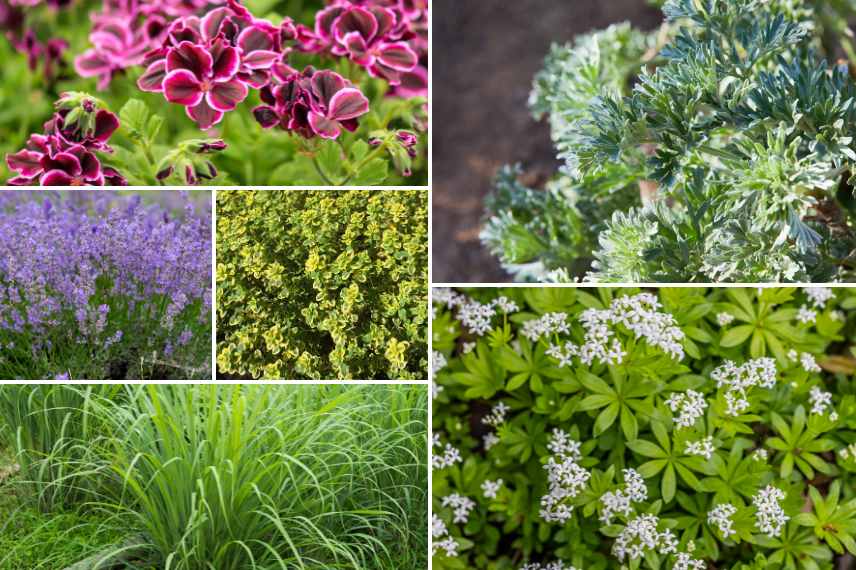
Six plants known to deter wasps (scented pelargonium, true lavender, lemon thyme, lemongrass, wormwood and sweet woodruff)
What if you created a buffer zone to attract them elsewhere?
Rather than trying to completely exclude wasps from the garden, wouldn’t it be wiser to divert them from the space we occupy with our loved ones? This strategy, respectful of biodiversity, relies on creating a buffer zone, far from the garden’s living area, reserved for wasps and other beneficial insects. Because yes, wasps in the garden are essential as beneficial insects. They contribute to pollination and the regulation of many pests, while also providing food for some birds:
- As wasps are attracted to flower nectar, you can leave a corner of the garden slightly wild and grassy or sow nectariferous plants.
- If you have a few fruit trees in an orchard, away from living areas, don’t hesitate to leave some damaged or overripe fruit, especially in late summer when nectar becomes scarce, to feed the worker wasps from the nests.
- Set up a dedicated water source for wasps. A shallow dish with a few pebbles or driftwood is enough to keep them safe.
- If you’ve spotted a nest located far from the most frequented areas of the garden, it’s best to leave it in place. If it poses no danger to children or pets, avoid having it removed by a professional, as it contributes to the garden’s ecological balance. You can even cordon off the area with barriers or tape while explaining the reasoning behind it.
And what do you think about fake nests?
There are fake wasp nests on the market, resembling large inflatable lanterns in a greyish colour, which are placed when the founding queens are looking to establish their colony. Upon seeing the artificial nest, the queens are supposed to flee, thinking the territory is already occupied. Why not, but without feedback, it’s difficult to give an opinion.
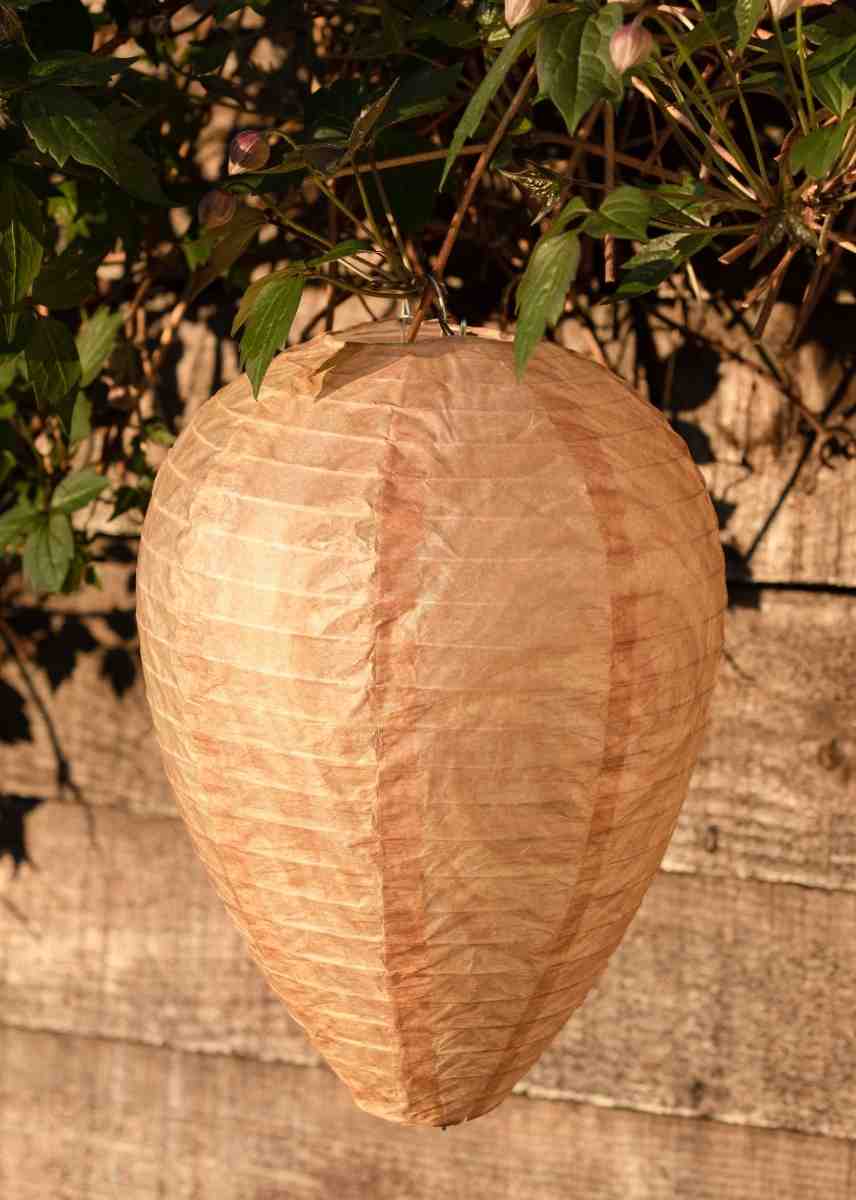
A fake nest to deter wasps from the garden
If you’ve tried this decoy, feel free to share your feedback on its effectiveness or uselessness…
- Subscribe!
- Contents
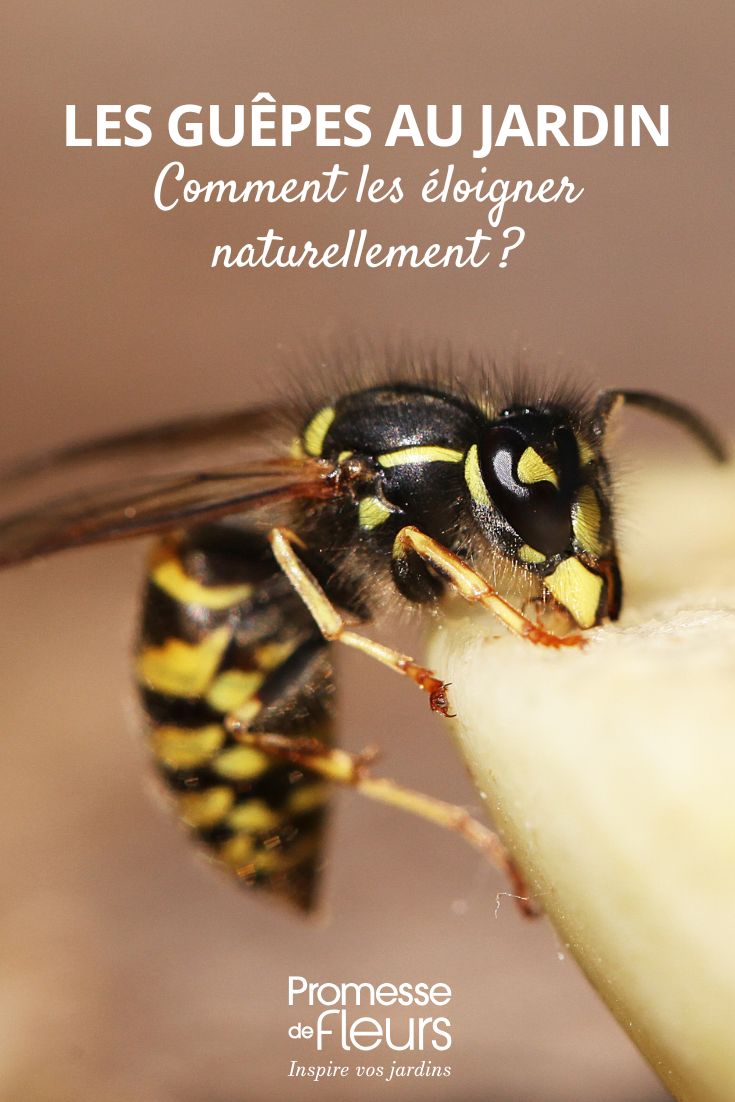































Comments